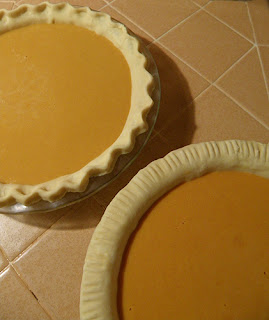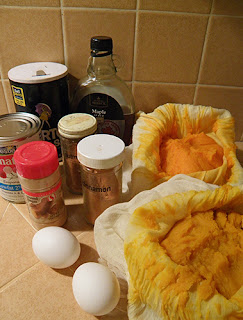 |
| The Contenders |
Pumpkin or Squash Pie Filling Recipe by Mom & Robin
The votes are in on the Christmas pies, despite a bit of a recipe fail.
On all counts, the best pumpkin pie seems to be made with butternut squash. In
fact, many bakeries that make pumpkin pie actually use butternut. It resembles
pumpkin in flavor, but is sweeter. It has a lower water content than pumpkin,
which means that you can eliminate draining it in cheesecloth after cooking and
mashing if you’re in a hurry. Pumpkin does have a distinct if subtle flavor
that is somewhat earthier than butternut. Because of this subtle flavor
difference Elizabeth, our Christmas hostess, stated that next we need to test
fresh butternut vs. canned pumpkin puree. Since butternut is currently so
inexpensive and can be used in so many ways, that test might not happen soon.
 |
| Pumpkin (left) & Butternut |
Leftover steamed butternut can be eaten as is for a side
dish. Leftover steamed pumpkin would be better seasoned and made into soup or muffins,
or otherwise fussed with. As mentioned above, DIY pureed
pumpkin requires draining, but draining is optional for butternut. Be
assured that I’m not dissing pumpkin pie made with real pumpkin. The classic
pumpkin flavor cannot be duplicated by butternut. Most Christmas diners voted
for the butternut flavor over pumpkin, but both were enjoyed.
 |
| Pumpkin (front) & Butternut & All the Rest |
 |
| Comparing Steamed Butternut (left) & Pumpkin |
This recipe is written as a stand-alone “crustless pie” or
pudding that is steamed in the oven. You may choose instead to bake it in a
premade (by you or otherwise) piecrust. (I will report later on piecrusts, when
I’ve had more
successful results with them.) Just don’t bake both a pie and the pudding
at once, because the water from the steam will make the piecrust soggy. Enjoy
your 4th day of Christmas!
2 lbs. butternut squash or ~3.5 lb. sugar pie pumpkin
2 eggs, at room temperature
12 oz. can low- or no-fat evaporated milk
½ cup maple syrup
¼ cup brown sugar
2 tbsp. flour
½ tsp. salt
1 tsp. cinnamon
½ tsp. ginger
¼ tsp. nutmeg
¼ cup white sugar: ONLY if using pumpkin
9” unbaked piecrust (optional)
Make Squash or Pumpkin Puree:
Squash: Remove stem
from butternut squash, peel, and cut in half. Remove seeds and stringy orange
fibers. Cut into large chunks, about 1½ inches square. Steam for 20 minutes.
Test for doneness. If not soft, continue steaming and checking every 3 minutes
or so until soft. Use an immersion blender or food processor to puree the
squash. If you have time, drain squash puree in cheesecloth-lined sieve over a
bowl for 2 – 24 hours.
Pumpkin: Wash
pumpkin, remove stem, and cut in half. Remove seeds and stringy fibers. Cut
pumpkin into large wedges. Steam for 20 minutes. Test for doneness. If not
soft, continue steaming and checking every 3 minutes or so until soft. Cool
pumpkin until it can be handled and scoop out pulp from skin. Use an immersion
blender or food processor to puree the pumpkin. Drain pumpkin puree in a
cheesecloth-lined sieve over a bowl for at least 2 hours, and up to 24 hours,
squeezing cheesecloth together to extract liquid occasionally. See more
detailed instructions at DIY
pumpkin puree post.
Squash or Pumpkin:
Measure 2 cups of puree into large mixing bowl.
Preheat oven to 350 degrees F (425 degrees F for pie).
Assemble Wet and Dry Ingredients:
Beat eggs until light and fluffy. Beat in milk and maple
syrup.
In a small bowl, combine brown sugar, flour, cinnamon,
ginger, and nutmeg. Stir in white sugar, only if using pumpkin.
Put it All Together:
Stir the sugar mixture into the squash or pumpkin puree
until well-distributed. Whisk egg mixture into squash or pumpkin until
well-blended.
Pour into individual custard cups, pie plate, or 1½ quart casserole. Set
cups or casserole into baking dish or pie plate and fill with 1 inch of water.
Bake for 45 minutes (cups) to 1 hour (pie plate) to 1½ hour (casserole) at 350 degrees F. It is done
when knife inserted into center comes out clean.
For pie, pour into piecrust. Place pan on bottom shelf of
oven and bake at 425 degrees F for 15 minutes. Lower temperature to 350 degrees
F. Bake another 45 minutes, or until knife inserted in center comes out clean.

No comments:
Post a Comment